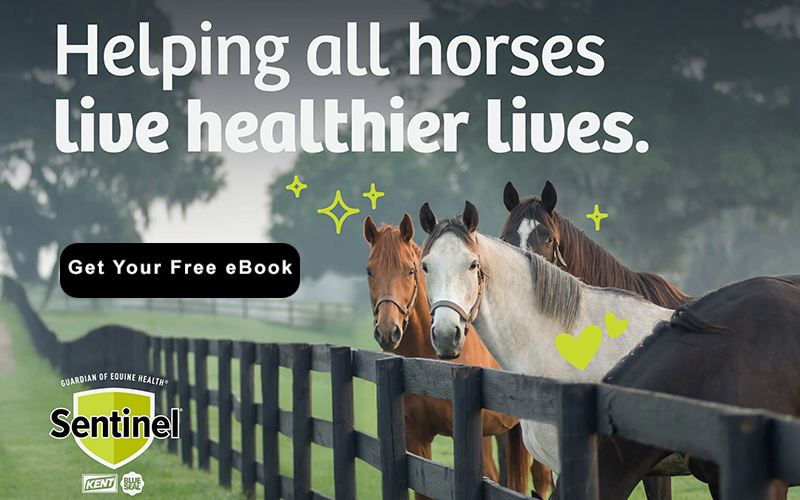Health & Education
We all want the best care possible for our horses. The Heath & Education section covers both Learning Institutions, Organizations as well as many sources for equine assistance including Veterinarians and Farriers.
For those who want a to formally study horses, the Education section includes College Riding, Equine Studies, and Veterinary Schools. Learn about the wide variety of horses in the Horse Breeds section. Supplements and Treatments Therapy are also included in the section.
Everyone can learn from Fine Art and there are some specialty Museums that might surprise you.
Horses as a therapy partner enrich the lives of the disabled. These facilities are listed in our Therapeutic Riding section. To help children and young adults build confidence and grow emotionally, please see the resources available on the Youth Outreach page.
Looking for a place to keep your horse? You can find it in the Horse Boarding section. Traveling? Find a Shipping company or Horse Sitting service if your horse is staying home!
Want to stay up to date with the latest training clinics or professional conferences? Take a look at our Calendar of Events for Health & Education for the dates and locations of upcoming events.
Do we need to add more? Please use the useful feedback link and let us know!
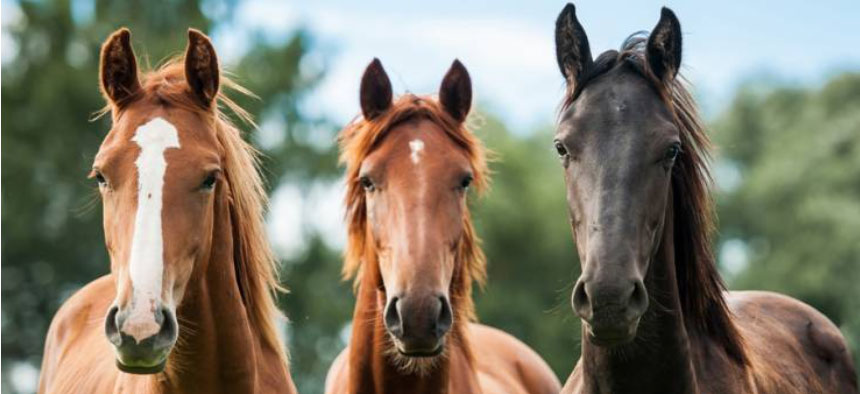
By Kentucky Equine Research Staff
Many horse owners are familiar with using artificial lights on broodmares to advance the breeding season or on show horses to help keep short, slick hair coats. Recently, Japanese researchers used artificial lighting on young, growing Thoroughbreds and found that extending a yearling’s photoperiod in winter increased muscle mass. The use of artificial lights to manipulate muscling may offer a unique way of helping prepare young horses for their two-year-old careers.
Previous research found that young Thoroughbreds bred in northern Japan, Hokkaido, suffer a decrease in growth rate in the winter between weaning and the first year and again between the first and second year of life. Further, there is a lower rate of increases in body weight, height at withers, girth circumference, and cannon bone circumference in the winter between the yearling and second year compared to young horses reared in southern Japan where the photoperiod is longer.
The increased rate of growth in Thoroughbreds raised in southern Japan is thought to be, at least partly, attributable to the activation of hormones involved in the hypothalamic-pituitary-gonadal axis as well as the growth hormone-insulin-like growth factor-1 axis as the photoperiod lengthens.
Another published study in Japan reported that the growth rate and shedding of winter coats were accelerated by applying extended photoperiod confirming that photoperiod affects more than just reproductive hormones.
Hoping to build on the current data, veterinarians from the Japanese Racing Association and Tokyo University placed 41 Thoroughbred yearlings under artificial lights to provide 14.5 hours of daily light from December 20th until April 15th. They measured body weight and fat-free mass throughout the extended photoperiod, comparing those measurements to 32 Thoroughbred yearlings maintained under natural lighting only. All horses were in northern Japan, in Hokkaido, a similar latitude as southern France and the Great Lakes in North America.
“One key finding of the study was that extending the photoperiod decreased the decline in growth rate in colts compared to those raised without lights, but the same effect was not seen in fillies,” said Ashley Fowler, Ph.D., a Kentucky Equine Research nutritionist.
Further, fat-free mass increased with age in both colts and fillies with the extended photoperiod, but the effect of extending the photoperiod on fat-free mass was more pronounced in colts than in fillies.
“These results support the idea that fat-free mass increases with longer day length. This may be a result of activating the hypothalamic-pituitary-gonadal axis and increasing circulating insulin-like growth factor-1 levels that play a role in muscle growth and development; however, further research is needed to elucidate those pathways more explicitly,” Fowler said.
Based on these results, artificial lights may be used in concert with modified training practices during the winter months to prepare young horses for competition as two-year-olds.
“To support increased muscle mass and training loads, bone density should also be considered. Triacton contains bioavailable calcium and other bone-building nutrients to help increase bone density in growing and exercising horses,” shared Fowler.
Read more: Extending Photoperiod for Muscle Development in Young Horses
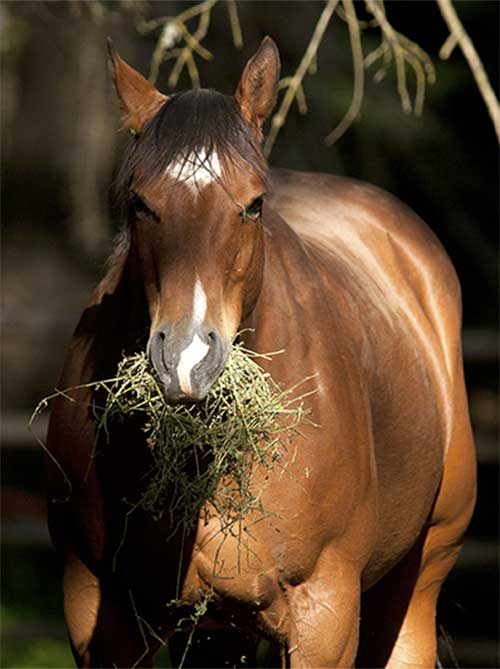
By Juliet M. Getty, Ph.D.
Guidelines from Dr. Getty on feeding the horse in transition to domesticated
If there’s one thing we can say about the benefit of being wild (or feral, in healthful surroundings) is that in most circumstances horses which have been free to roam open lands are often healthier than domesticated horses. Think about their diet for starters—they have so much variety—grasses, flowers, berries, leaves, seeds, fruits—providing all the nutrients their bodies need. Once they leave this natural setting, however, they typically eat only hay and it’s the same hay every day. Hay is dead grass and no longer contains the vitamins found in their previous, varied diet. The horse’s nutrition gaps will need to be filled in order to match the rich nutrition of the wildenvironment. Therefore, to fill in the nutritional gaps:
Provide a comprehensive vitamin/mineral supplement along with chia seeds and ground flaxseeds for omega 3s
Horses in the wild rarely experience colic. One of the main reasons for colic in the domesticated situation is the rapid change from one feed to another, leaving the bacterial hindgut population little time to adjust. These microbes are responsible for digesting the fiber found in forage (hay and/or pasture) and need to be protected. To help your new horse’s digestive system adjust:
Feed a potent probiotic that contains billions of colony forming units (CFUs)
Ulcers are common in domesticated horses, especially when transitioning to a new environment. Horses are trickle feeders – they need to graze continuously to keep the digestive system functioning normally. That means they should have quality hay 24/7. Horses are awake and moving most of the time and will take 15 to 20 minute naps intermittently throughout the day and night. The best way to protect your new horse against an ulcer is to:
Feed him in sync with his natural instinct to continuously graze by giving him hay, free-choice
Many wild horses get adopted when they are young. They require the variety of feed sources that they had in the wild that offered quality protein, fat, vitamins, and minerals to support new growth. To accomplish this, add some alfalfa to your horse’s diet (about 30% of the total hay ration), along with either a supplement or a commercially fortified feed. Avoid cereal grains (oats, corn, etc.) and molasses – they can interfere with normal bone and joint development. In general:
Feed growing horses extra protein, vitamins and minerals, chia seeds and ground flaxseeds to provide omega 3s, while avoiding high amounts of starch
Respect your horse’s need to roam, along with other horses. Naturally curious, they enjoy seeking out feed in various locations, feeding their bodies, but also providing movement to keep the digestive tract muscles in good tone. And being prey animals, they depend on the companionship of other horses to protect them against threats, real and imagined. This transition phase can be stressful – new sights, smells, people, and other animals can create a hormonal response that can lead to a variety of health problems, including ulcers, colic, and laminitis. All of these can be avoided by making slow adjustments, filling in nutritional gaps, and doing as much as possible to simulate a natural setting. In other words…
- Feed him like he was meant to be fed – like a horse.
This article originally appeared on Getty Equine Nutrition and is published here with permission.
Find more informative articles in our section on Health & Education.
In episode #64 of StallSide, we dive into thoroughbred stallion management with Sandy Hatfield; hosted by doctors Bart Barber and Peter Morresey, this episode offers a glimpse into the life of the esteemed Stallion Manager at Three Chimneys Farm. Listeners can learn about the unique challenges and joys that come with the job of a Stallion Manager.
Sandy Hatfield discusses the importance of patience, socialization, exercise, personalities, teaser stallions, and training of breeding stallions. Her insights provide a valuable perspective for both seasoned breeders and those new to the world of thoroughbred breeding.
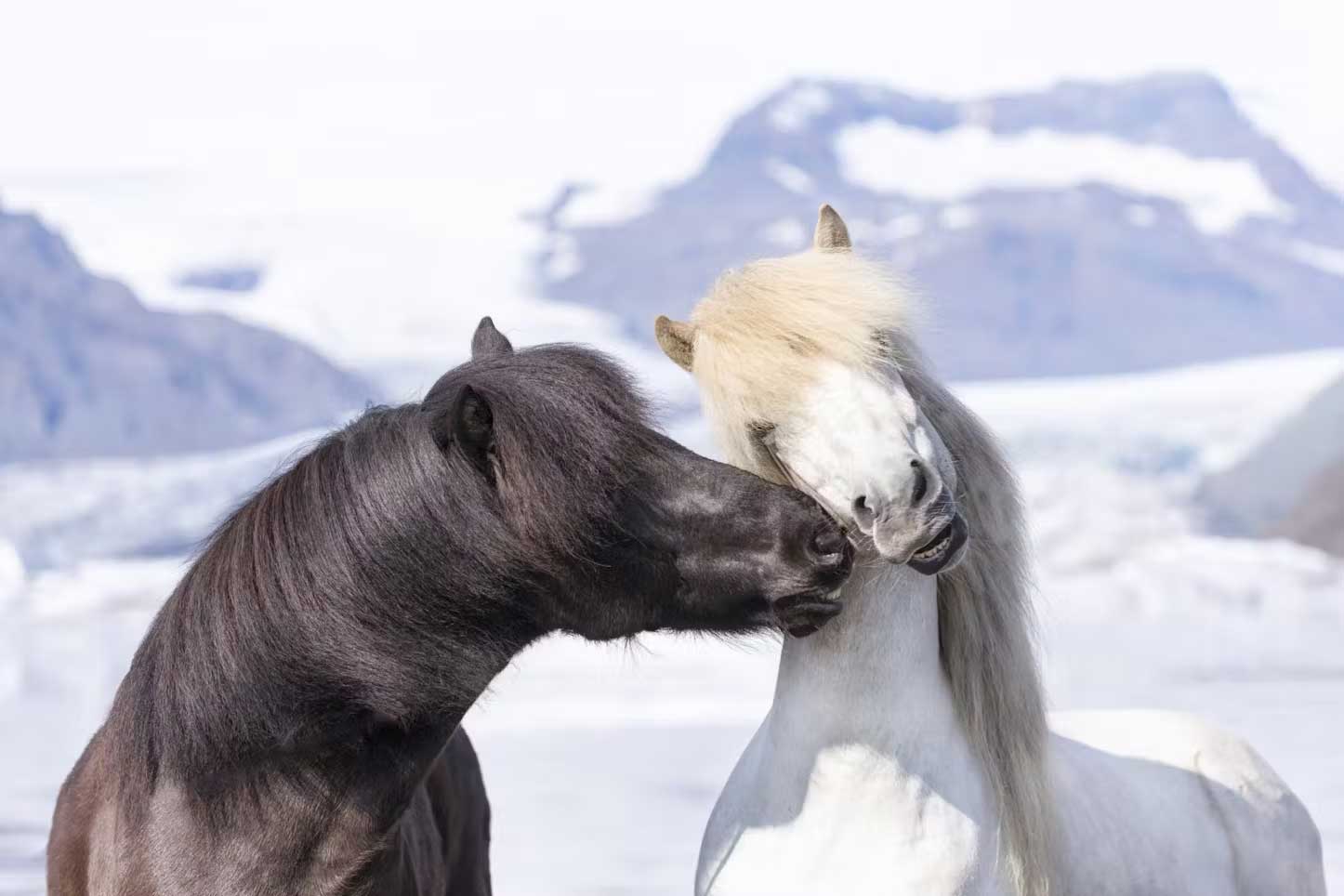
The Icelandic horse is one of the most colorful breeds in the world.
The Icelandic horse has over 40 colors and up to 100 variations and, with only few exceptions, most of the known horse colors can be found within the breed. This fact adds both to the charming look of the Icelandic horse and to variation within the breed. Not only are all colors allowed in the studbook, but variety is encouraged, as the official breeding goal is simply to preserve all colors naturally occurring in the breed.
Although the commonly known statement “a good horse has no color” is true to a degree, people often have their favourites and will discuss the range and characteristics of colors extensively.
COLORS AND GENETICS
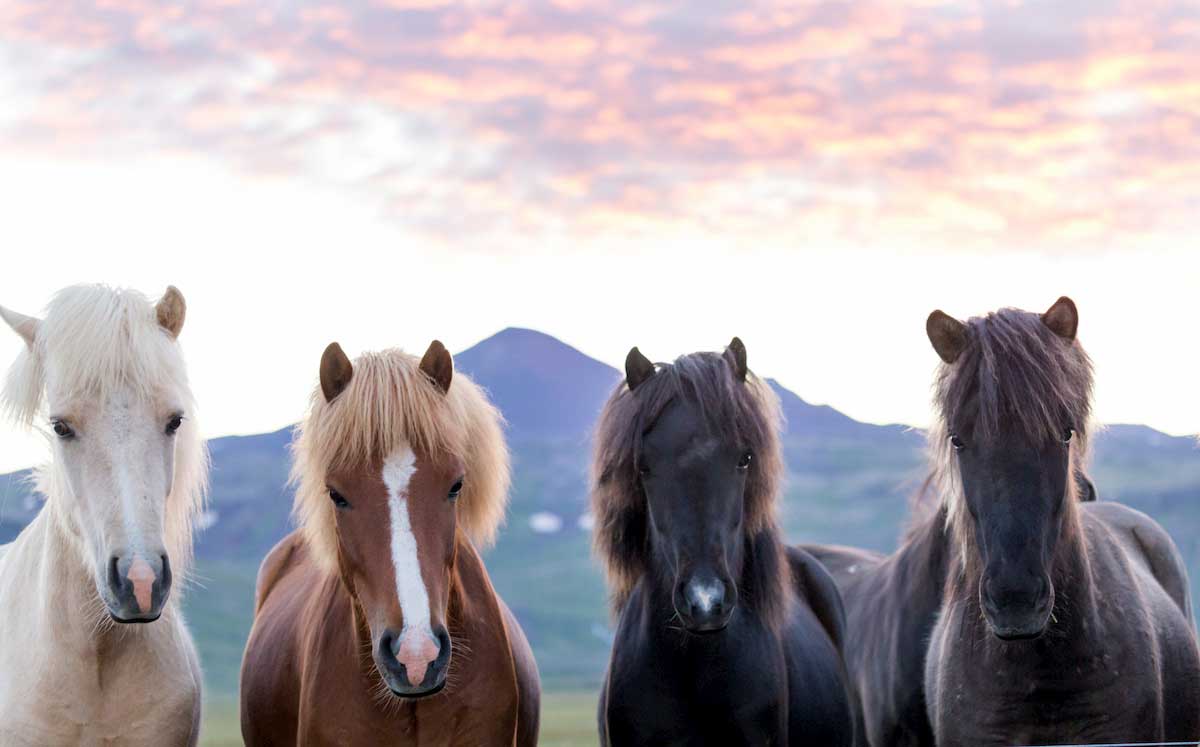
The most common colors are red (chestnut) and black (brown). All horses have a base colour that can vay from black, red/chestnut or bay. Black horses can be either heterozygote – containing both the red and black genes – or fully black, where red offspring would be impossible. The red base color comes when both parents give the red gene, but it is not a dominant gene, meaning it only shows as red when in homozygote state, that is, when inherited from both parents. Therefore, if both parents are red, the foal can only be red.
VARIATIONS OF COLOR
On top of these base colors come all the variations, like skewbald, dun, palomino, grey, silver dapple, splash-skewbald and roan. These can often also be combined so the same horse can have a black base color, but have both the dun gene and the silver dapple gene, making the outcome much lighter than the base color prescribes. Grey can come on top of all colors and basically means that the horses turn white with age.
The silver dapple variation is hidden in the red base color, so although not shown, it can be present and inheritable. In bay and black base colors, it lightens the mane and tail as well as the body to some degree, causing the famous “chocolate color” when the base color is black. Although very pretty, it is crucial to breed silver dapple horses carefully as a link has been found between multiple congenital ocular anomalies (MCOA) and this color when the horse is homozygote.
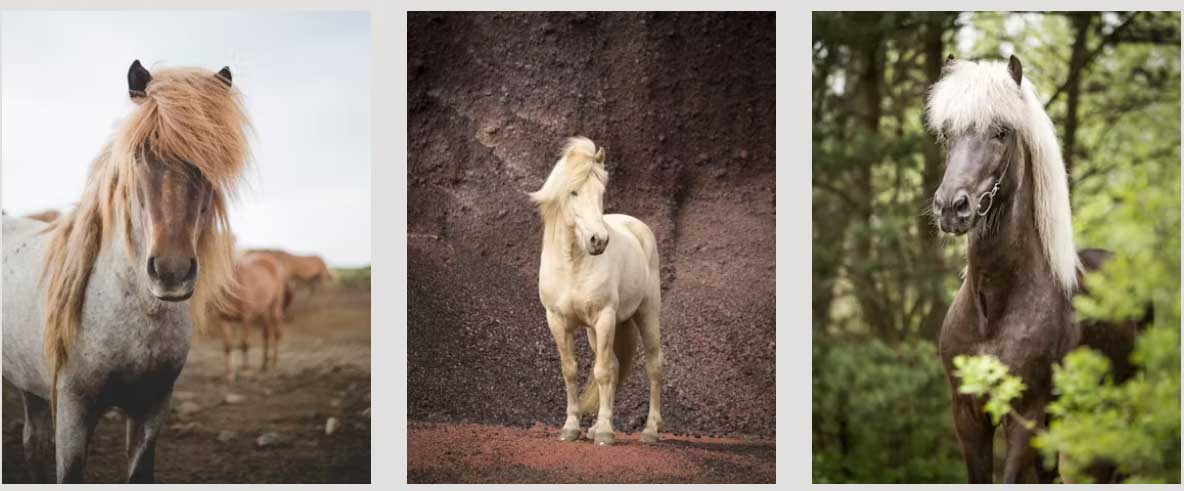
The rarest color variations found in Icelandic horses are sabino and roan. Until 2003, no sabino variation had ever been seen within the breed but a mare was then born in Germany with a specific sabino mutation. In 2013, a second, different sabino mutation occurred, this time in Iceland and in a stallion. Every Icelandic sabino horse can now be traced to one of those two horses.
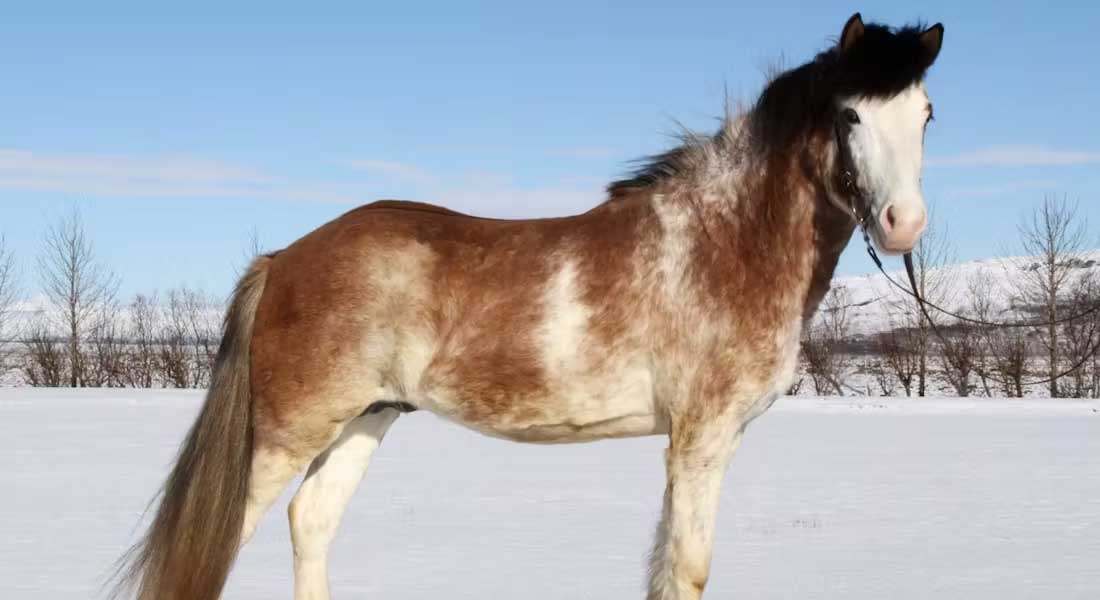
The second rarest color variation of Icelandic horses is roan. Icelandic roans are often called color-changers, because the horses with this variation show their “real” color in summer coat as well as in full winter coat, but in spring and autumn the middle layer in their coat has no color, and is, in other words, white.
On top of all the possible colors and variations, multiple add-ons such as a blaze, star, snip, socks or other markings can also be found within the Icelandic horse breed, making each horse as unique on the outside as on the inside.
This article originally appeared on The Horses of Iceland and is published here with permission.
You can find more interesting articles in our section on Health & Education.
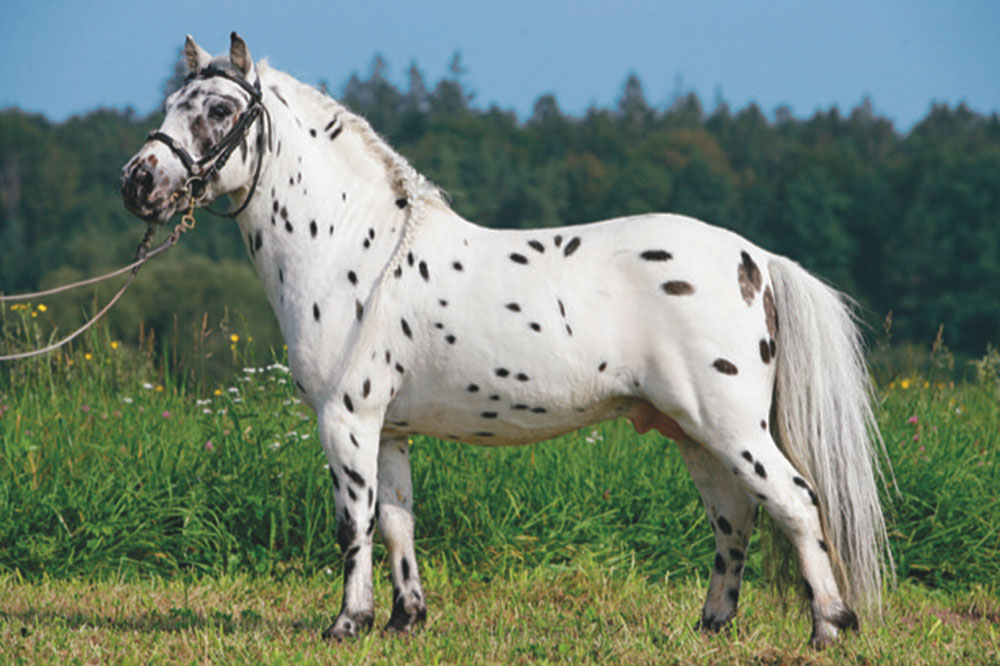
The following is an excerpt from Mini School – Train Your Mini to Be All He Can Be, by Sabine Ellinger
Today’s stylish and perfectly proportioned Miniature Horses are the product of nearly 400 years of selective breeding. Classically elegant, gentle by nature, and appealing to people of all abilities, sizes, and ages, this small and unique equine stands no taller than 34 inches at the withers as measured from the last hairs of the mane. The American Miniature Horse Association (AMHA) has established an official “Standard of Perfection” in which the general impression of the Miniature Horse should be “A small, sound, well-balanced horse, possessing the correct conformation characteristics required of most breeds, [including] refinement and femininity in the mare [and] boldness and masculinity in the stallion. The general impression should be one of symmetry, strength, agility, and alertness. Since the breed objective is the smallest possible perfect horse, preference in judging shall be given to the smaller horse, other characteristics being approximately equal (www. amha.org).
The Importance of Conformation
Severe conformation flaws can still occur but not to the extent that was the case 20 years ago. The modern-day Mini has been bred with more emphasis placed on his suitability for driving and riding. Quality of the gaits, jumping ability, conformation, and temperament have all been enormously improved in the past two decades because in addition to the suitability for specific disciplines, breeders have put a strong emphasis on breeding and creating a cooperative and friendly a Mini as possible.
Conformation flaws usually won’t really affect a Mini’s ability to perform tricks, but they can pose difficulties when training him in dressage, driving, or jumping. Minis often do not have ideal conformation because many breeders select their breeding stock with a focus on small size rather than on other physical parameters. Poorly set necks, improperly angled or weak hindquarters, a lack of room in the throatlatch, and bad bone structure can make training and conditioning a Mini for an equestrian discipline much more difficult and in some cases nearly impossible.
The same criteria that apply to the conformation of full-size horses are relevant in Minis. Thick throatlatches limit the horse’s ability to flex at the poll, weak hindquarters hinder collection, and crooked legs make the horse less resilient over time. The Mini’s smaller size and the fact that he is not ridden—or at least not ridden to the same degree his full-size cousin is—makes the severity of the problems relative.
Evaluating Conformation
When selecting a Mini for training, the buyer should choose one that resembles a “scaled-down” version of a normal-size riding horse. With a critical eye, you’ll want to evaluate the following points:
Head
A Mini should have a kind face with big, expressive eyes. You can tell a lot about his character just by looking at his facial expression. The shape of the head is not so important but a “clean” throatlatch is crucial. A thick throatlatch makes it very difficult for a Mini to “give” at the poll, which should be as moveable as a ball bearing. Wide cheek bones combined with a thick throatlatch area are quite common and are unfortunately very limiting.
-
Neck
A correctly shaped neck enables correct contact with the bit and the handler’s hands, and thus establishes a better connection with the Mini. Ewe-necks, “swan necks” (those that are unusually long and set on too high), and low-set necks are much more difficult to work with to achieve an optimal connection with the Mini’s mouth. The neck should be wide at the base, set relatively high, and should taper gradually and harmoniously up to the poll.
-
Shoulders
An elastic, swinging stride can only come out of a well-angled, sloping shoulder. Minis with upright shoulders tend to hurry and “shuffle along.”
-
Back
A well-shaped, gently curved back of an appropriate length facilitates dressage and driving training. The development of impulsion (forward thrust generated by the hindquarters) and carrying capacity (ability of the hindquarters to assume more of the Mini’s weight and reverse his natural heaviness on the forehand), and everything else that comes from the hind end relies on a “swinging” and supple back. Swaybacks and roach backs are stiff and inflexible, making it harder for the Mini to perform.
-
Croup
If a croup-high Mini is asked to collect (an optimal state of balance with more weight over his lowered hindquarters and with a gently rounded topline), he must expend vastly more energy than one with better hind end conformation. Most collected movements, depending on the degree of collection required, may not be possible for a croup-high Mini.
-
Hindquarters
The hindquarters are the Mini’s engine! It is hard for a Mini to compensate for conformational flaws in this area. Correctly angled hind legs make collection immensely easier. The hindquarters should be as broad as possible from the top down in order to allow enough room for optimal muscle development.
-
Bone Structure
The Mini’s legs carry his body. For him to withstand work, he should have clean legs and feet. They should be straight and without serious conformational defects. The legs will have to withstand stress if the Mini is to jump, or perform collected movements or “airs above the ground”. More pronounced joints are usually more resilient. Otherwise the legs should be “clean” with no spongy spots or bumps.
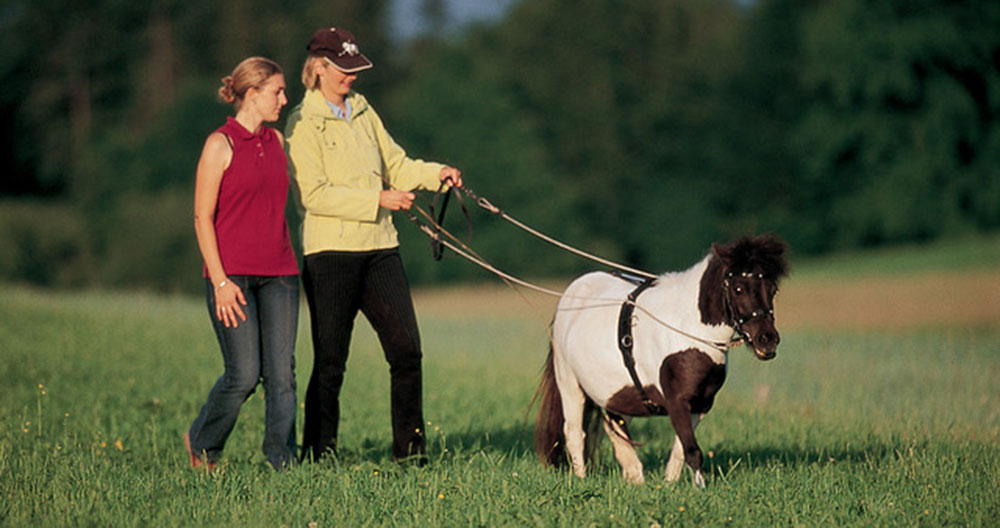
Although you may not care to always be “looking for a problem,” you must be able to recognize and evaluate conformational faults in a prospective Mini purchase. There are some that do not hinder a Mini’s training and should not discourage a buyer. However, there are others that make any sort of work—in hand or in harness—a constant challenge, despite the Mini’s best efforts. Such a Mini must work many times harder to achieve the same results as one with good conformation. When you are informed about what good and poor conformation looks like in a Mini, you will be better able to create a training program that is suitable for the Mini with whom you are working.
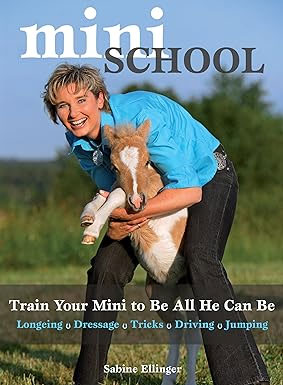
BUY NOW ON AMAZON
Hardcover | Paperback
This excerpt from Mini School was published with permission from Trafalgar Square Books. You can also visit them at Horse & Rider Books.
There a more really interesting books on riding and all aspects of equestrian living in our section on Books.
Julie Goodnight shows you the proper and safe way to handle or hold the horse for the Vet or Farrier
For more information on the largest certifying body of riding instructors and barn managers in North America, Certified Horsemanship Association, please visit www.CHA.horse.
Read more: Holding the Horse for the Vet or Farrier with Julie Goodnight (7:03)
Julie Goodnight shows the proper fit and adjustment of the Running and Standing Martigale.
Read more: Fitting the Martigale with Julie Goodnight (12:33)

Understand signs of colic in horses and horse colic treatment recommendations
Colic is a potentially fatal condition that is on every horse owner’s mind. The severity of colic ranges from simple abdominal pain to potentially life-threatening, sometimes requiring surgical treatment.
On an annual basis, for every 100 horses, there will be 4.2 colic events; 1.2 percent will require surgery and some 11 percent of cases will be fatal, according to the American Association of Equine Practitioners and the National Animal Health Monitoring System (NAHMS).
Causes of Colic in Horses
Caused by any number of factors, colic can be categorized by impaction colic, when feed materials build up in the gut of the horse. This is often caused by coarse feed, poor water intake, or a block in the digestive tract. Also common is gas colic, when the microbes in the colon excessively produce amounts of gas. This can be caused by changes in feed. A shift in the colon can cause the intestines to flip or twist, leading to impactions and gas build-up. When the colon twists, emergency surgery is immediately required. Ulcers, poor motility and blood supply also contribute to the condition.
Signs of Colic in Horses
There are varying symptoms of colic in horses:
- Looking at, scratching or kicking the abdomen
- Pacing
- Pawing
- Sweating
- Lying down and rolling, at times violently
- Posturing to urinate without normal urine output
- Decreased interest in hay and grain
- Heart rate more than 45 beats per minute
- Discolored mucous membranes
Steps to Take with Colic in Horses
If you notice mild signs and suspect your horse may be experiencing colic, immediately bring him to a confined area to closely monitor him. Watch for any change in attitude, signs of pain or manure output. Walking your horse can provide pain relief and help your horse, if he is experiencing cramps or colic. Doing so also helps prevent your horse from rolling. Discontinue walking if you notice that doing so progresses the pain and overall symptoms.
If your horse continues to display these symptoms and act abnormally, call your veterinarian. And if you have not observed your horse in several hours and notice these symptoms, immediately contact your veterinarian, as it is possible your horse has experienced colic for an extended period of time.
What to do While Waiting for Your Veterinarian
- Remove your horse’s access to feed.
- Take your horse’s vitals to share with your veterinarian.
- Walk your horse to help prevent rolling and further damage (again, only if it does not cause him more pain).
Colic Treatment
Fortunately, more than 80 percent of colic types have positive outcomes when treated on the farm. Prescription medications for colic help ease abdominal pain and reduce inflammation. Banamine and Buscopan are the industry go-tos for providing mild pain relief. The antispasmodic properties of Buscopan help with gas-related colic, spasmodic colic, and some impactions. Phenylbutazone also can reduce inflammation and relieve some pain from colic. Digestive supplements, like Succeed, also help support a healthy digestive system for reduced colic risk.
Ann Brzezicki, CHA Master Instructor and Director of Equestrian Programs at Middle TN State University, demonstrates how to teach the horse to lengthen and shorten their stride. This is a educational video brought to you by the Certified Horsemanship Association (CHA.horse).
Read more: Lengthening and Shortening the Horse's Strides with Ann Brzezicki (20:31)
- Equine Asthma: Current Understanding and Future Directions Research - Dr Dorothee Bienzle (14:25)
- The Real Cost of Horse Ownership - Jackie Bellamy-Zions (5:51)
- Keeping Dogs Safe around Horses and Livestock
- 5 Winter Plus Senior Horse Care Tips
- How to Measure for Hoof Boots
- The Benefit of Barn Cats!
- Treating a foal's Overbite with Dr Brad Tanner from Rood & Riddle Equine Hospital
- Biosecurity for Horse Owners
- Biosecurity: When and How to Isolate
- Do You Ride Big or Small? and excerpt from "Ride Big" by John Haime
- Rood & Riddle "Stallside" Podcast - The Science and Benefits of Equine Plasma with Sarah Myer Thompson (38:11)
- Olfactory Stimulation Enriches Horses’ Environments
- Whole Food Options to Boost Protein Quality
- Monty Roberts Gentling Your Spooky Horse (4:17)
- The Biomechanics of Engagement :The Essential Components of Self Carriage (18:19)
- Monty Roberts: A Real Horse Whisperer (49:43)
- Julie Goodnight: Don't wear a bike helmet for horseback riding-- here's why.... (0:30)
- Julie Goodnight: Quick Tip to Stay out of Horse's Kick Zone, CHA (0:29)
- The Uniqueness of Icelandic horses, Part 2 (7:15)
- Beyond Dust Reduction: Soaking Hay Improves Lung Function in Asthmatic Horses






